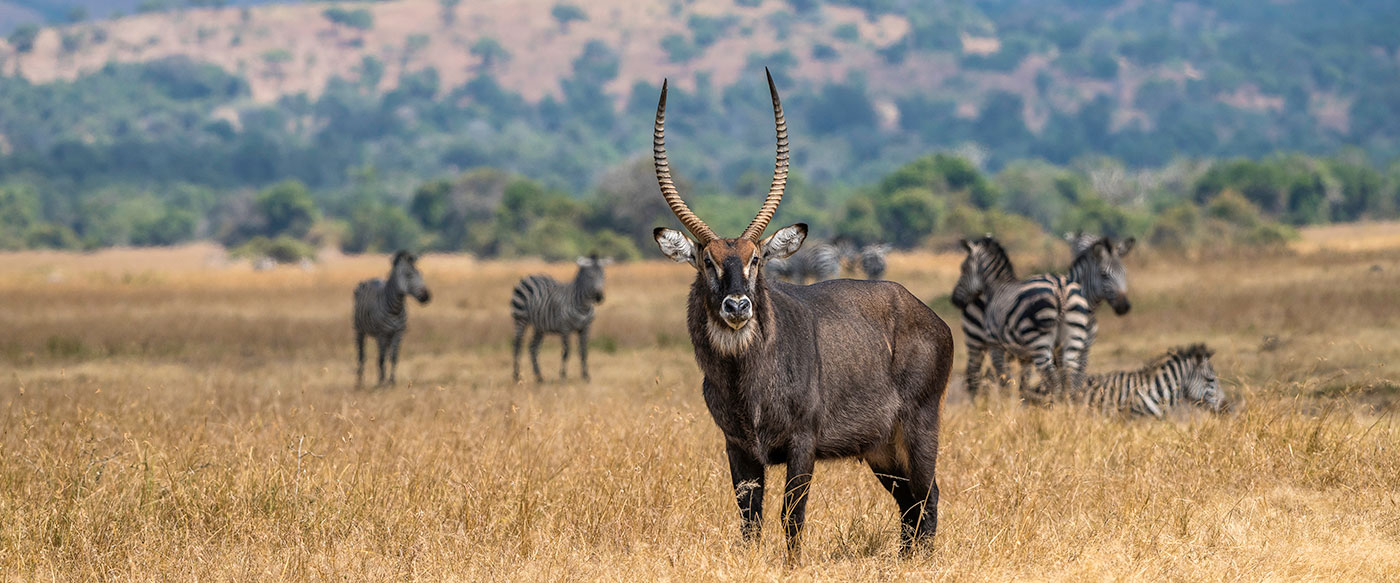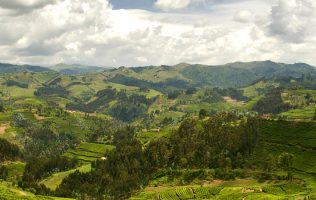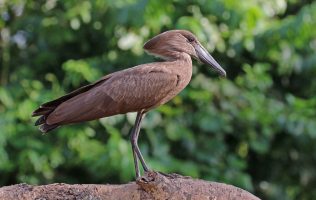An antelope is a member of a number of even-toed ungulate species indigenous to various regions in Africa and Eurasia. The 91 antelope species, most of which are native to Africa, occur in about 30 genera. The classification of tribes or subfamilies within Bovidae
Antelope are not a cladistics or taxonomically defined group. The term is used to describe all members of the family Bovidae that do not fall under the category of sheep, cattle, or goats. Usually, all species of the Alcelaphinae, Antilopinae, Hippotraginae, Reduncinae, Cephalophinae, many Bovinae, the grey rhebok, and the impala are called antelopes.
Antelopes comprise a wastebasket taxon (miscellaneous group) within the family Bovidae, encompassing those Old World species that are not cattle, sheep, buffalo, bison, yaks, or goats; even so, antelope are generally more deer-like than other bovids. A group of antelope is called a herd.
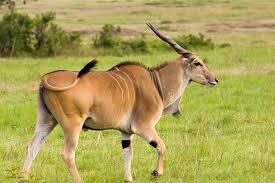
- The Eland.
Diet: primarily grass and leaves (herbivore)
This is the largest antelope in Africa, also known as the southern eland or eland antelope, is a savannah and plains antelope found in East and Southern Africa. It is a species of the family Bovidae and genus taurotragus. An adult male is around 1.6 meters (5′) tall at the shoulder (females are 20 centimetres (8″) shorter) and can weigh up to 942 kg (2,077 lb.) with an average of 500–600 kg (1,100–1,300 lb.), 340–445 kg (750–981 lb.) for females). It is the second largest antelope in the world, being slightly smaller on average than the giant eland.
The common elands form herds of up to 500 animals, but are not territorial. The common eland prefers habitats with a wide variety of flowering plants such as savannah, woodlands, and open and montane grasslands; it avoids dense forests. It uses loud barks, visual and postural movements and the flehmen response to communicate and warn others of danger. The common eland is used by humans for leather, meat, and rich, nutritious milk, and has been domesticated in many areas.
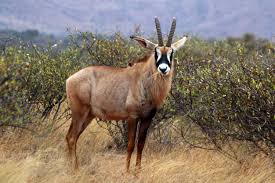
Roan antelope.
It’s the largest antelope mostly occurred in east and southern Africa, (Hippotragus equinus) a woodland & grassland savanna antelope found in west ,central ,east and southern Africa.
Roan antelope are one of the largest species of antelopes, only Elands, Bongos and large male Kudus can exceed them in weight. They measure 190–240 cm (75–94 in) from the head to the base of tail and the tail measures 37–48 cm (15–19 in). The body mass of males is 242–300 kg (534–661 lb) and of females is 223–280 kg (492–617 lb.)The shoulder of this species is typically around 130–140 cm (51–55 in).[4][5][6] Named for their roan color (a reddish brown), they have lighter underbellies, white eyebrows and cheeks and black faces, lighter in females.
They have short, erect manes, very light beards and prominent red nostrils. The horns are ringed and can reach a meter long in males, slightly shorter in females. They arch backwards slightly.
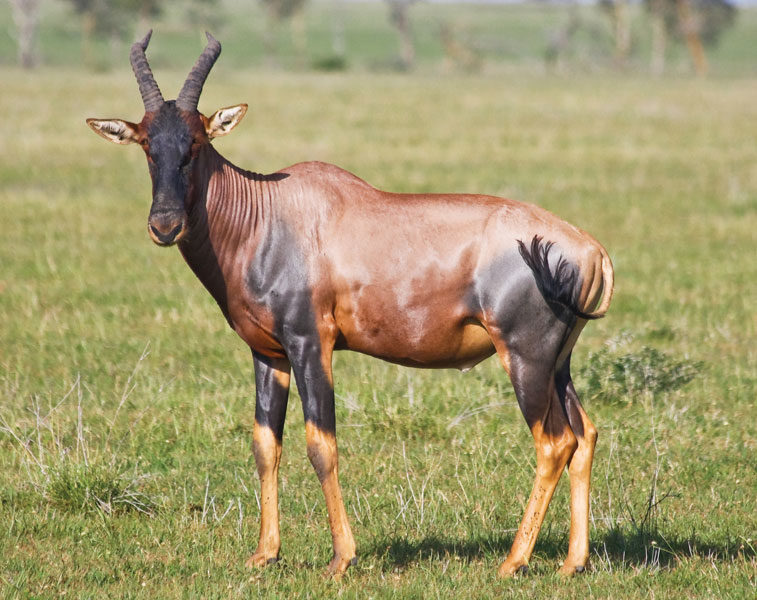
- The Topi antelope
The Topi (Damaliscus lunatus jimela) is a highly social and fast antelope subspecies of the common tsessebe, a species which belongs to the genus Damaliscus. They are found in the savannas, semi-deserts, and floodplains of sub-Saharan Africa.
Topi resemble hartebeest but have a darker coloration and lack sharply angled horns. They have elongated heads; a distinct hump at the base of the neck, and reddish brown bodies with dark purple patching’s on their upper legs.
They also have a mask-like dark coloration on the face. Their horns are ringed and lyrate shaped. Their coats are made of short, shiny hairs. They range in mass from 68 to 160 kg (150 to 353 lb.). Head-and-body length can range from 150 to 210 cm (59 to 83 in) and the tail measures 40–60 cm (16–24 in). They are a tall species, ranging in height from 100 to 130 cm (39 to 51 in) at the shoulder. Males tend to be larger and darker than females. Topi also have preorbital glands that secrete clear oil and the front legs have hoof glands.
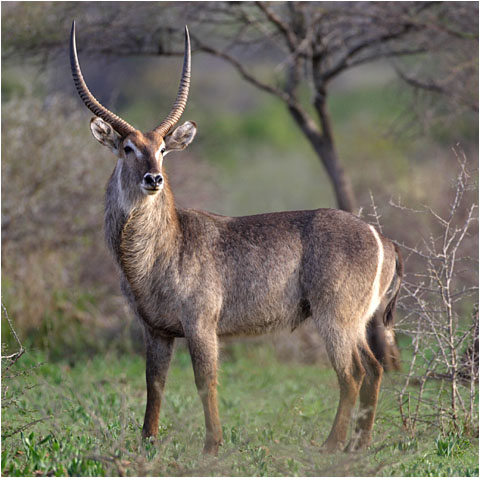
- The Waterbuck.
Mostly found close to water land in savanna and one of the largest antelope. The waterbuck (Kobus ellipsiprymnus) is a large antelope found widely in sub-Saharan Africa. It is placed in the genus Kobus of the family Bovidae. It was first described in 1833. The thirteen subspecies are grouped under two varieties. The thirteen subspecies are grouped under two varieties: the common or Ellisprymnus waterbuck and the Defassa waterbuck.
The head-and-body length is typically between 177–235 cm (70–93 in) and the average height is between 120 and 136 cm (47 and 54 in). A sexually dimorphic antelope, males are taller as well as heavier than females. Males reach approximately 127 cm (50 in) at the shoulder, while females reach 119 cm (47 in). Males typically weigh 198–262 kg (437–578 lb.) and females 161–214 kg (355–472 lb.). The coat colour varies from brown to grey. The long, spiral horns, present only on males, curve backward, then forward and are 55–99 cm (22–39 in) long.
Water-buck inhabit scrub and savanna areas along rivers, lakes and valleys. Due to their requirement for grasslands as well as water, the water-buck have a sparse ecotone distribution.
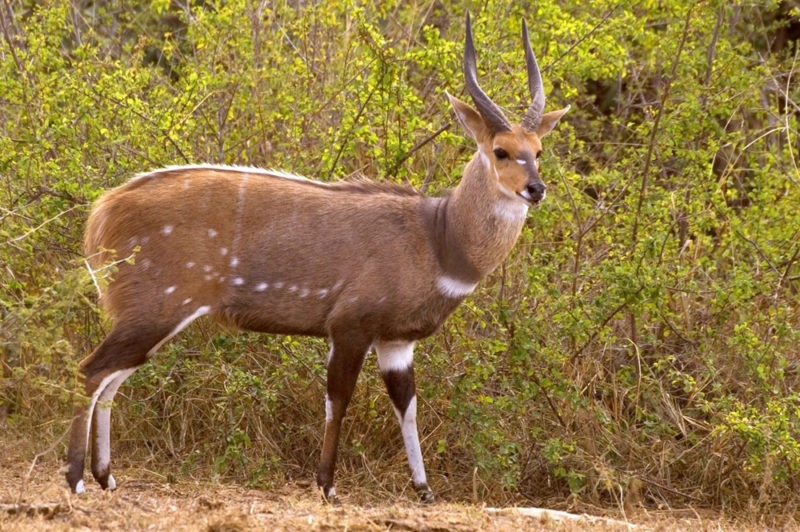
- The Bush buck antelope
The Cape bushbuck (Tragelaphus sylvaticus), or bushbuck as it is commonly known within its range, is a widespread species of antelope in Sub-Saharan Africa. To distinguish it from the kéwel (Tragelaphus scriptus), a close relative, and some scientific literature refers to it as the imbabala. The two “bushbuck” species have been found to be more closely related to other members of the tragelaphine family than to each other the imbabala namely to the bongo and sitatunga, and the kéwel to the nyala. Cape bushbucks are found in rain forests, montane forests, forest-savanna mosaic, savanna bush and woodland.
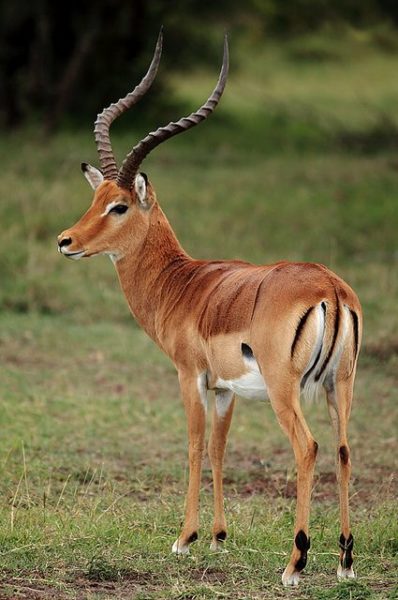
- The impalas
The impala is a medium-sized antelope found in eastern and southern Africa, similar to the grants gazelle. The sole member of the genus Aepyceros, it was first described to European audiences by German zoologist Hinrich Lichtenstein in 1812. Two subspecies are recognized, the common impala, and the larger and darker black-faced impala. The impala reaches 70–92 centimetres (28–36 inches) at the shoulder and weighs 40–76 kg (88–168 lb.)It features a glossy, reddish brown coat. The male’s slender, lyre-shaped horns are 45–92 centimetres (18–36 inches) long.
Active mainly during the day, the impala may be gregarious or territorial depending upon the climate and geography. Three distinct social groups can be observed: the territorial males, bachelor herds and female herds. The impala is known for two characteristic leaps that constitute an anti-predator strategy. Browsers as well as grazers, impala feed on monocots, dicots, forbs, fruits and acacia pods (whenever available).
An annual, three-week-long rut takes place toward the end of the wet season, typically in May. Rutting males fight over dominance, and the victorious male courts female in oestrus. Gestation lasts six to seven months, following which a single calf is born and immediately concealed in cover. Calves are suckled for four to six months; young males are forced out of the all-female groups to join bachelor herds, while females may stay back.
The impala is found in woodlands and sometimes on the interface (ecotone) between woodlands and savannahs; it inhabits places close to water.
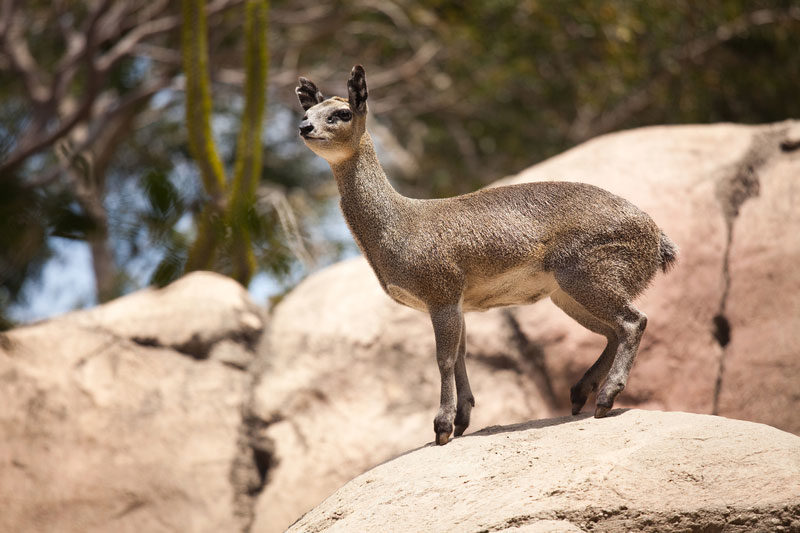
- The Klipspringer antelope
The Klipspringer is a small antelope found in eastern and southern Africa. The sole member of its genus, the klipspringer was first described by German zoologist Eberhard August Wilhelm von Zimmermann in 1783. The klipspringer is a small, sturdy antelope; it reaches 43–60 centimetres (17–24 in) at the shoulder and weighs from 8 to 18 kilograms (18 to 40 lb.). The coat of the klipspringer, yellowish gray to reddish brown, acts as an efficient camouflage in its rocky habitat. Unlike most other antelopes, the klipspringer has a thick and coarse coat with hollow, brittle hairs. The horns, short and spiky, typically measure 7.5–9 centimetres (3.0–3.5 in).
The klipspringer rests during the middle of the day and late at night. A gregarious animal, the klipspringer is monogamous to a much greater extent than other antelopes; individuals of opposite sexes exhibit long-term to lifelong pair bonding. The mates tend to stay as close as within 5 meters (16 ft.) of each other at most times.
Males form territories, 7.5–49 hectares (19–121 acres), in which they stay with their partners and offspring. Primarily a browser, the klipspringer prefers young plants, fruits and flowers. Gestation lasts around six months, following which a single calf is born; births peak from spring to early summer. The calf leaves its mother when it turns a year old.
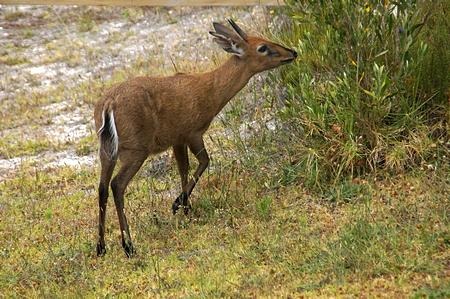
- The common duiker antelope
Diet: beyond herbivorous browsing for leaves, flowers, fruits and tubers, they will also eat insects, frogs, small birds and mammals, and even carrion.
The common duiker also known as the grey or bush duiker, is a small antelope found in everywhere in Africa south of the Sahara, excluding the Horn of Africa and the rainforests of the central and western parts of the continent. Generally, they are found in habitats with sufficient vegetation cover to allow them to hide savanna and hilly areas, including the fringes of human settlements.
Breeding is year round and the female gives birth to one fawn after a gestation period of 6 to 7.5 months. As long as they have vegetation to eat (from which they get some water), they can go without drinking for very long periods. In the rainy season, they will frequently not drink water at all, instead obtaining fluids from fruits. They will often scavenge for these fruits below trees in which monkeys are feeding. They are active both day and night, but become more nocturnal near human settlements.
Males are territorial and smear gland secretions on rocks and branches to mark their territories; their preferred resting places are generally on elevated ground, where they can observe their territory. Females, by contrast, prefer deeper cover. The overall success of this species stems from its ability to inhabit a wide variety of habitats, as well as from its adaptable, generalist diet.
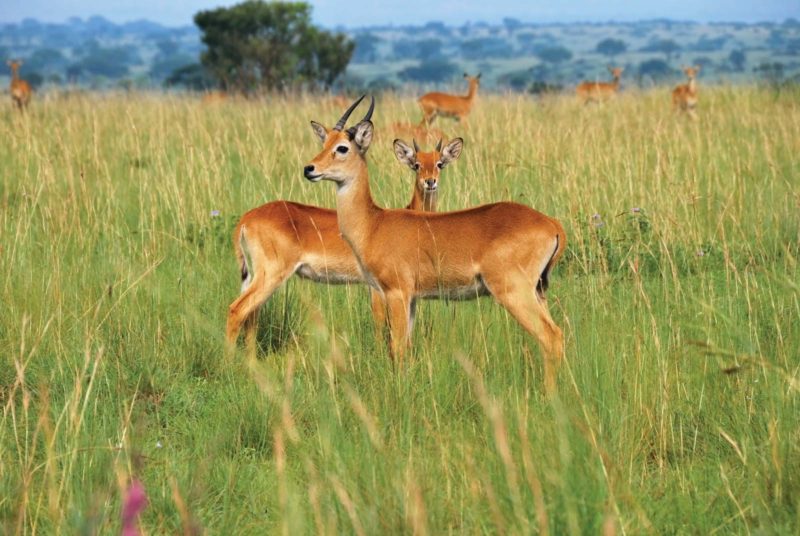
- The reedbuck antelope
The reedbuck is an antelope native to central Africa. The animal is placed under the genus Redunca and in the family Bovidae. It was first discovered in 1767. The bohor reedbuck has five subspecies.
The head-and-body length of this medium-sized antelope is typically between 100–135 cm (39–53 in). Males reach approximately 75–89 cm (30–35 in) at the shoulder, while females reach 69–76 cm (27–30 in). Males typically weigh 43–65 kg (95–143 lb.) and females 35–45 kg (77–99 lb.). This sturdily built antelope has a yellow to grayish brown coat. Only the males possess horns which measure about 25–35 cm (9.8–13.8 in) long.
An herbivore, the bohor reedbuck prefers grasses and tender reed shoots with high protein and low fiber content. This reedbuck is dependent on water, though green pastures can fulfill its water requirement.
The social structure of the bohor reedbuck is highly flexible. Large aggregations are observed during the dry season, when hundreds of bohor reedbuck assembles near a river. Males become sexually mature at the age of three to four years, while females can conceive at just one year of age, reproducing every nine to fourteen months. Though there is no fixed breeding season, mating peaks in the rainy season. The gestation period is seven and a half months long, after which a single calf is born. The calves are weaned at eight to nine months of age.
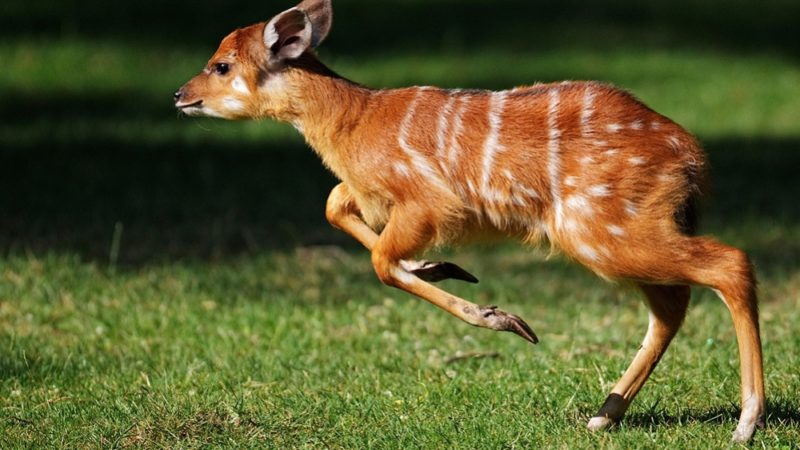
- The sitatunga antelope
The sitatunga is a swamp dwelling antelope; it is confined to swampy and marshy habitats. Here they occur in tall and dense vegetation as well as seasonal swamps, marshy clearings in forests, riparian thickets and mangrove swamps.
The sitatunga is a medium-sized antelope. It is sexually dimorphic, with males considerably larger than females. The head-and-body length is typically between 136–177 cm (54–70 in) in males and 104–146 cm (41–57 in) in females. Males reach approximately 81–116 cm (32–46 in) at the shoulder, while females reach 72–90 cm (28–35 in). Males typically weigh 76–119 kg (168–262 lb.), while females weigh 24–57 kg (53–126 lb.)The tail is 14–37 cm (5.5–14.6 in) long. The saucer-shaped ears are 11–17 cm (4.3–6.7 in) long.[5] Only the males possess horns; these are spiral in shape, have one or two twists and are 45–92 cm (18–36 in) long.
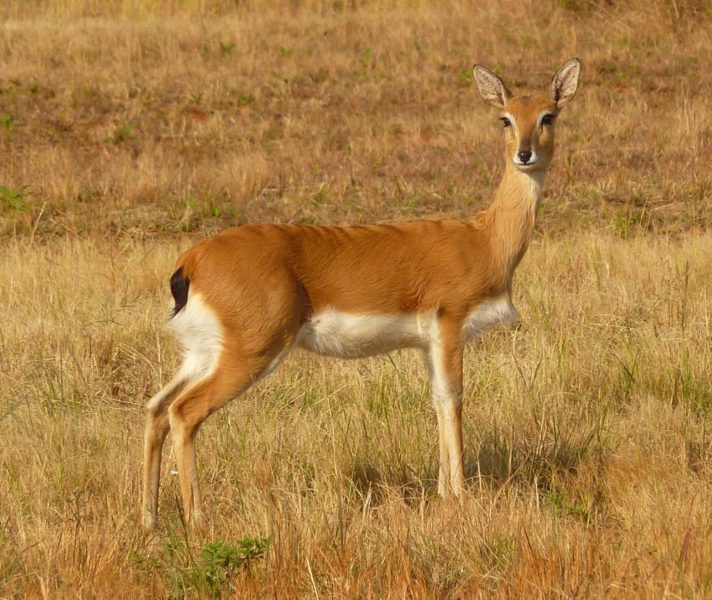
- The Oribi antelope
The Oribi is a small antelope found in eastern, southern and western Africa. The sole member of its genus, the oribi was first described in 1782. Eight subspecies are identified. The oribi reaches nearly 50–67 centimetres (20–26 in) at the shoulder and weighs 12–22 kilograms (26–49 lb.)This antelope features a slightly raised back and long neck and limbs. The glossy, yellowish to rufous brown coat contrasts with the white chin, throat, under parts and rump. Only males possess horns; the thin, straight horns, 8–18 centimetres (3.1–7.1 in) long, are smooth at the tips and ringed at the base.
The oribi is active mainly during the day. Small herds of up to four members are common; males defend their group’s territory, 25–100 hectares (62–247 acres) large. The oribi is primarily a grazer, and prefers fresh grasses and browses occasionally. A seasonal breeder, the time when mating occurs varies geographically. Unlike all other small antelopes, oribi can exhibit three types of mating systems, depending on the habitat polyandry, polygyny and polygynandry. Gestation lasts for six to seven months, following which a single calf is born; births peak from November to December in southern Africa. Weaning takes place at four to five months.
The oribi occurs in a variety of habitats from savannas, floodplains and tropical grasslands with 10–100 centimetres (3.9–39.4 in) tall grasses to montane grasslands at low altitudes, up to 2,000 meters (6,600 ft.) above the sea level.

